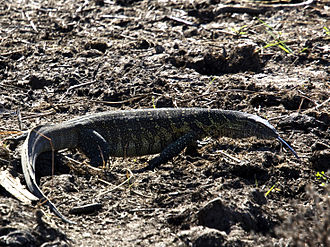Type the name of the breed you're looking for below
[wpdreams_ajaxsearchlite] Don't see the breed your're looking for? Click here and let us know!
Nile Monitor
| Place of Origin and Range | Nile monitors are native to Africa and the species is distributed throughout the entire central and southern regions of the continent, including Sudan and a portion of central Egypt along the Nile river. They are not found in any of the desert regions of Africa, however, as they thrive around rivers. |
| Description | They have muscular bodies, strong legs, and powerful jaws. Their teeth are sharp and pointed in juvenile animals and become blunt and peg-like in adults. They also possess sharp claws used for climbing, digging, defence, or tearing at their prey. Like all monitors, they have forked tongues, with highly developed olfactory properties. The Nile monitor has quite striking, but variable, skin patterns, as they are greyish-brown above with greenish-yellow barring on the tail and large, greenish-yellow rosette-like spots on their backs with a blackish tiny spot in the middle. Their throats and undersides are an ochre-yellow to a creamy-yellow, often with faint barring. |
| Morph Patterns Available | Yes |
| Adult Size | Can grow up to 3- 5 feet( 0.9-1.5 m) |
| Accommodation | This is a water monitor by any observation. Lots of clean water. A high heat basking spot at 100 F (36 C). A large cage or dedicated room would be best. |
| Lifespan | Can live up to 20 years |
| Feeding / Diet | Their main foods in captivity are whole prey, such as mice, rats, snakes, lizards, freshwater mollusks, small birds, large roaches, crustaceans, fish, and eggs. A varied diet with dusted insects, crayfish and other low fat foods is by far the best, but they will readily eat mice. |
| Other Considerations | The potential for the established population of Nile monitors in Lee, Charlotte, and other counties in Florida, to negatively impact indigenous crocodilians (American alligator Alligator mississippiensis and American crocodile Crocodylus acutus) is enormous given that they normally raid crocodile nests, eat eggs, and prey on small crocodiles in Africa. Anecdotal evidence indicates a high rate of disappearance of domestic pets and feral cats in Cape Coral. It also prey on other invasive species such as the Burmese Python egg nest. Nile monitors require experienced care as pets and are not recommended for beginners; nevertheless they are often found in the pet trade. Albino (amelanistic) specimens have been found and propagated in captivity. |



